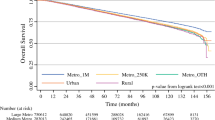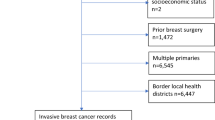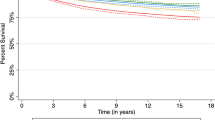Abstract
Background
Using the 2006 Surveillance, Epidemiology, and End Results (SEER) database and the 2004 Area Resource File (ARF), the likelihood of mastectomy for stages I–III breast cancer patients in urban versus rural populations are examined. County and patient level data are evaluated for impact on receipt of mastectomy. Patient variables included age, stage, race, and marital status, and community variables are income, employment, and radiation facility staff density. The likelihood of mastectomy in urban and rural patients, and the impact of the different variables on that procedure, is reported.
Methods
This retrospective analysis of a combined dataset from the 2006 SEER database and the 2004 ARF linked using the federal information processing standard (FIPS) state county variable evaluates patient and county variables with multivariate regression.
Results
From 1992 to 2003, 137,303 patients were identified in the SEER database. The rural population (county population of <20,000) comprised 9.58% of the overall population. On bivariate analysis, the likelihood of mastectomy was significantly higher among rural patients (59.90% versus 44.92%, P < 0.001). Multivariate analysis demonstrated that rural residency is an independent factor affecting receipt of mastectomy (odds ratio [OR] 1.58, 95% confidence interval [CI] 1.26–1.97). The likelihood that a patient received a mastectomy was impacted by the significant patient factors of stage at diagnosis, race, and marital status, and significant community factors were employment, education level, and density of radiation technologists.
Conclusion
An increased likelihood of mastectomy for rural patients with stages I–III breast cancer is shown with analysis of patient and community factors that may play a role.

Similar content being viewed by others
References
Early Breast Cancer Trialists’ Collaborative Group. Effects of radiotherapy and surgery in early breast cancer. An overview of the randomized trials. N Engl J Med 1995; 333:1444–55
Fisher B, Anderson S, Bryant J, et al. Twenty-year follow-up of a comparing total mastectomy, lumpectomy, and lumpectomy plus irradiation for the treatment of invasive breast cancer. N Engl J Med 2000;347:1233–41
Veronesi U, Cascinelli N, Mariani L, et al. Twenty-year follow-up of a randomized study comparing breast-conserving surgery with radical mastectomy for early breast cancer. N Engl J Med 2002; 347:1227–32
Farrow DC, Hunt WC, Samet JM. Geographic variation in the treatment of localized breast cancer. N Engl J Med 1992; 326:1097–101
Farrow DC, Samet JM, Hunt WC. Regional variation in survival following the diagnosis of cancer. J Clin Epidemiol 1996; 49:843–7
Howe HL, Johnson TP, Lehnherr M, et al. Patterns of breast cancer treatment: a comparison of a rural population with an urban population and a community clinical oncology program sample. Cancer Control 1995; 2:113–20
Howe HL, Katterhagen JG, Yates J, et al. Urban-rural differences in the management of breast cancer. Cancer Causes Control 1992; 3:533–9
Gold HT, Dick AW. Variations in treatment for ductal carcinoma in situ in elderly women. Med Care 2004; 42:267–75
Mitchell KJ, Fritschi L, Reid A, et al. Rural-urban differences in the presentation, management and survival of breast cancer in western Australia. Breast 2006; 15:769–76
Schroen AT, Brenin DR, Kelly MD, et al. Impact of patient distance to radiation therapy on mastectomy use in early-stage breast cancer patients. J Clin Oncol 2005; 23:7074–80
Tropman SE, Ricketts TC, Paskett E, et al. Rural breast cancer treatment: evidence from the reaching communities for cancer care (REACH) project. Breast Cancer Res Treat 1999; 56:59–66
Meden T, St John-Larkin C, Hermes D, et al. MSJAMA. Relationship between travel distance and utilization of breast cancer treatment in rural northern Michigan. JAMA 2002; 287:111
Nattinger AB, Gottlieb MS, Veum J, et al. Geographic variation in the use of breast-conserving treatment for breast cancer. N Engl J Med 1992; 326:1102–7
Nattinger AB, Kneusel RT, Hoffmann RG, et al. Relationship of distance from a radiotherapy facility and initial breast cancer treatment. J Natl Cancer Inst 2001; 93:1344–6
Fontana V, Castro T, Polynice A. Preferences of healthy inner city women and the surgical treatment of early stage breast cancer. Am Surg 2007; 73:215–21
Schootman M, Aft R. Rural-urban differences in radiation therapy for ductal carcinoma in-situ of the breast. Breast Cancer Res Treat 2001; 68:117–25
Stafford D, Szczys R, Becker R, et al. How breast cancer treatment decisions are made by women in North Dakota. Am J Surg 1998; 176:515–9
Desch CE, Penberthy L, Newschaffer CJ, et al. Factors that determine the treatment for local and regional prostate cancer. Med Care 1996; 34:152–62
Johantgen ME, Coffey RM, Harris DR, et al. Treating early-stage breast cancer: Hospital characteristics associated with breast-conserving surgery. Am J Public Health 1995; 85:1432–4
Gelber RP, McCarthy EP, Davis JW, et al. Ethnic disparities in breast cancer management among Asian Americans and Pacific Islanders. Ann Surg Oncol 2006; 13:977–84
Lannin DR, Mathews HF, Mitchell J, et al. Influence of socioeconomic and cultural factors on racial differences in late-stage presentation of breast cancer. JAMA 1998; 279:1801–7
Liff JM, Chow WH, Greenberg RS. Rural-urban differences in stage at diagnosis. Possible relationship to cancer screening. Cancer 1991; 67:1454–9
Fagerlin A, Lakhani I, Lantz PM, et al. An informed decision? Breast cancer patients and their knowledge about treatment. Patient Educ Couns 2006; 64:303–12
Bradley CJ, Neumark D, Luo Z, et al. Employment and cancer: findings from a longitudinal study of breast and prostate cancer survivors. Cancer Invest 2007; 25:47–54
Maunsell E, Brisson C, Dubois L, et al. Work problems after breast cancer: an exploratory qualitative study. Psychooncology 1999; 8:467–73
Area Resource File (ARF) 2004 Release. National Center for Health Workforce Analysis, Bureau of Health Professions, Health Resources and Services Administration, Department of Health and Human Services
US National Institutes of Health. Surveillance epidemiology and end results: Providing information on cancer statistics to help reduce the burden of this disease on the US population. Available: http://www.seer.cancer.gov/ [accessed June 25, 2007]
Cultice J (2000) Area resource file: National county-level health resource information database. Available: http://www.arfsys.com/ [accessed June 25, 2007]
National Cancer Institute. Available: http://www.cancer.gov/ [accessed June 25, 2007]
Ries L, Eisner M, Kosary C, et al. SEER Cancer Statistics Review, 1975–2002. Bethesda, MD: National Cancer Institute; 2005
Osborne MP. William Stewart Halsted: his life and contributions to surgery. Lancet Oncol 2007; 8:256–65
Beaulieu JE, Massey CS, Tucker TC, et al. Rural-urban variation in breast-conserving surgery in Kentucky. J Ky Med Assoc 2003; 101:455–9
Kim P. Cost of cancer care: the patient perspective. J Clin Oncol 2007; 25:228–32
Athas WF, Adams-Cameron M, Hunt WC, et al. Travel distance to radiation therapy and receipt of radiotherapy following breast-conserving surgery. J Natl Cancer Inst 2000; 92:269–71
Schootman M, Fuortes LJ. Breast and cervical carcinoma: the correlation of activity limitations and rurality with screening, disease incidence, and mortality. Cancer 1999; 86:1087–94
Liff JM, Sung JF, Chow WH, et al. Does increased detection account for the rising incidence of breast cancer? Am J Public Health 1991; 81:462–5
Answini GA, Woodard WL, Norton HJ, et al. Breast conservation: trends in a major southern metropolitan area compared with surrounding rural counties. Am Surg 2001; 67:994–8
Bao Y, Fox SA, Escarce JJ. Socioeconomic and racial/ethnic differences in the discussion of cancer screening: “between-” versus “within-” physician differences. Health Serv Res 2007; 42:950–70
Gelber RP, McCarthy EP, Davis JW, et al. Ethnic disparities in breast cancer management among Asian Americans and Pacific islanders. Ann Surg Oncol 2006; 13:977–84
Clifford E, Clifford M, Georgiade NG. Breast reconstruction following mastectomy: II. Marital characteristics of patients seeking the procedure. Ann Plast Surg 1980; 5:344–6
Nattinger AB, McAuliffe TL, Schapira MM. Generalizability of the surveillance, epidemiology, and end results registry population: factors relevant to epidemiologic and health care research. J Clin Epidemiol 1997; 50:939–45
Rosson GD, Singh NK, Ahuja N, et al. Multilevel analysis of the impact of community versus patient factors on access to immediate breast reconstruction following mastectomy in the state of Maryland. Arch Surg (in press)
United States Census Bureau (2007) Available: http://www.census.gov. [accessed on June 25, 2007]
Author information
Authors and Affiliations
Corresponding author
Rights and permissions
About this article
Cite this article
Jacobs, L.K., Kelley, K.A., Rosson, G.D. et al. Disparities in Urban and Rural Mastectomy Populations. Ann Surg Oncol 15, 2644–2652 (2008). https://doi.org/10.1245/s10434-008-0053-5
Received:
Revised:
Accepted:
Published:
Issue Date:
DOI: https://doi.org/10.1245/s10434-008-0053-5




